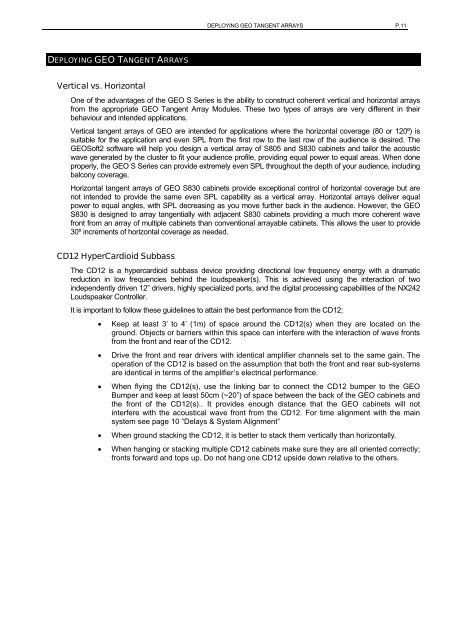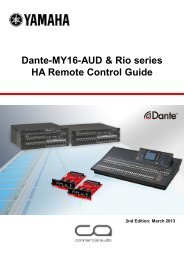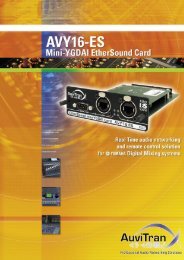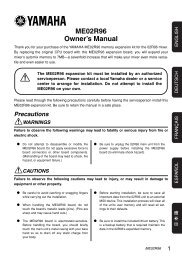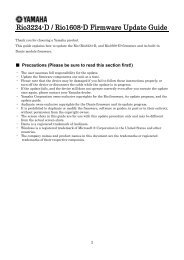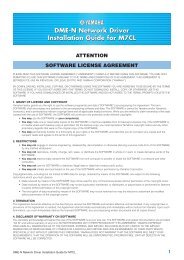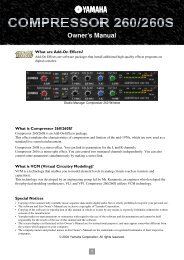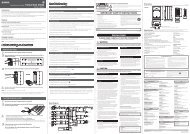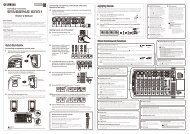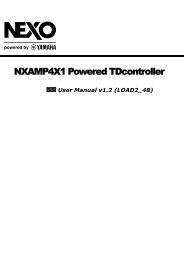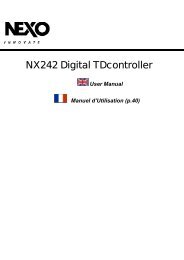Create successful ePaper yourself
Turn your PDF publications into a flip-book with our unique Google optimized e-Paper software.
DEPLOYING <strong>GEO</strong> TANGENT ARRAYS P.11DEPLOYING <strong>GEO</strong> TANGENT ARRAYSVertical vs. HorizontalOne of the advantages of the <strong>GEO</strong> S <strong>Series</strong> is the ability to construct coherent vertical and horizontal arraysfrom the appropriate <strong>GEO</strong> Tangent Array Modules. These two types of arrays are very different in theirbehaviour and intended applications.Vertical tangent arrays of <strong>GEO</strong> are intended for applications where the horizontal coverage (80 or 120º) issuitable for the application and even SPL from the first row to the last row of the audience is desired. The<strong>GEO</strong>Soft2 software will help you design a vertical array of S805 and S830 cabinets and tailor the acousticwave generated by the cluster to fit your audience profile, providing equal power to equal areas. When doneproperly, the <strong>GEO</strong> S <strong>Series</strong> can provide extremely even SPL throughout the depth of your audience, includingbalcony coverage.Horizontal tangent arrays of <strong>GEO</strong> S830 cabinets provide exceptional control of horizontal coverage but arenot intended to provide the same even SPL capability as a vertical array. Horizontal arrays deliver equalpower to equal angles, with SPL decreasing as you move further back in the audience. However, the <strong>GEO</strong>S830 is designed to array tangentially with adjacent S830 cabinets providing a much more coherent wavefront from an array of multiple cabinets than conventional arrayable cabinets. This allows the user to provide30º increments of horizontal coverage as needed.CD12 HyperCardioid SubbassThe CD12 is a hypercardioid subbass device providing directional low frequency energy with a dramaticreduction in low frequencies behind the loudspeaker(s). This is achieved using the interaction of twoindependently driven 12” drivers, highly specialized ports, and the digital processing capabilities of the NX242Loudspeaker Controller.It is important to follow these guidelines to attain the best performance from the CD12;• Keep at least 3’ to 4’ (1m) of space around the CD12(s) when they are located on theground. Objects or barriers within this space can interfere with the interaction of wave frontsfrom the front and rear of the CD12.• Drive the front and rear drivers with identical amplifier channels set to the same gain. Theoperation of the CD12 is based on the assumption that both the front and rear sub-systemsare identical in terms of the amplifier’s electrical performance.• When flying the CD12(s), use the linking bar to connect the CD12 bumper to the <strong>GEO</strong>Bumper and keep at least 50cm (~20”) of space between the back of the <strong>GEO</strong> cabinets andthe front of the CD12(s).. It provides enough distance that the <strong>GEO</strong> cabinets will notinterfere with the acoustical wave front from the CD12. For time alignment with the mainsystem see page 10 “Delays & System Alignment”• When ground stacking the CD12, it is better to stack them vertically than horizontally.• When hanging or stacking multiple CD12 cabinets make sure they are all oriented correctly;fronts forward and tops up. Do not hang one CD12 upside down relative to the others.


